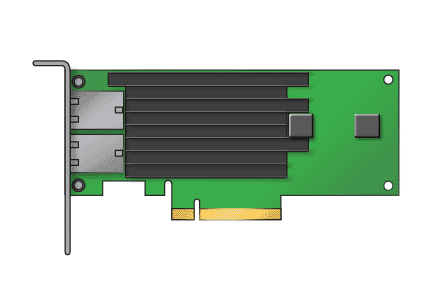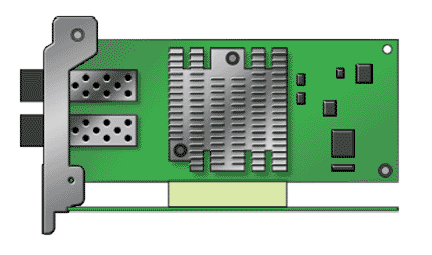An HBA is a circuit board installed inside the Replication Engine riser board assembly.
HBAs are installed in pairs in a Replication Engine to ensure that multiple data paths are available to the source or target storage. In the event of a failed HBA, the alternate HBA receives additional load. If the second HBA fails, the result would be a loss of replication services. To avoid the loss of service, an HBA should be replaced as soon as possible if a failure has been identified.
- Prerequisites:
Ensure that you have a Phillips Number 2 screwdriver with at least a 4-inch shaft.
Before handling a component, touch a grounded surface to discharge any static electricity.
Attach an electrostatic discharge (ESD) wrist strap to your wrist, and stand on an ESD mat while replacing components.
Keep filler panels available in case you only remove the HBA and do not plan to replace the HBA immediately.
Note: Filler panels ensure proper airflow inside the Replication Engine.Use only the filler panels provided with the Replication Engine to maintain proper airflow and EMI conformance for empty slots inside the Replication Engine.
Label all cables connected to the Replication Engine so that they can be reconnected accurately to the Replication Engine after the replacement procedure is complete.
Each Oracle Flash Storage System supports two types of HBA connectivity SAN (FC or iSCSI HBA 16Gb, optical only) and NAS (10 GbE HBA). The placement of the HBA inside the riser slot is based on the Oracle FS System configuration option selected. All HBAs supported in the Oracle FS System are customer replaceable units (CRUs). Replacement of an HBA requires you to bring the Replication Engine offline. HBAs connecting to host servers must be placed into slots 1, 4, and 5 on the risers. HBAs connecting to Drive Enclosures must be placed into slots 2, 3, and 6 on the risers. You must install all HBAs according to the slot numbers listed in the following table.
HBA |
Quantity and slot |
|---|---|
8 Gb/s dual-port Fibre Channel (FC) QLogic |
Two in slots 3 and 6 |
10 Gb/s dual-port Ethernet RJ45 |
Two in slots 2 and 5 |
10 Gb/s dual-port Ethernet copper or fibre SFP+ |
Three in slots 2, 4, and 5 |
Figure 1: 8 Gb/s dual-port Fibre Channel (FC) QLogic HBA

Figure 2: 10 Gb/s dual-port Ethernet RJ45 HBA

Figure 3: 10 Gb/s dual-port Ethernet copper or fiber SFP+ HBA
